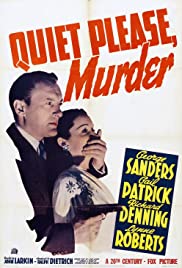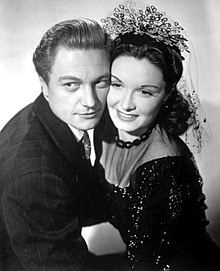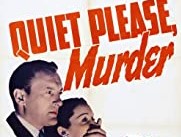Quiet Please: Murder **** (1942, George Sanders, Gail Patrick, Richard Denning, Lynne Roberts) – Classic Movie Review 9871
Shhhh… pray silence please… George Sanders is just committing a murder in the library… well that’s one way to get a book…
Director John Larkin’s 1942 Quiet Please: Murder is a pleasantly peculiar library-set crime-drama thriller tale about a smooth, ingenious, sado-masochist murderous forger called Jim Fleg (George Sanders), who commits murder to steal a priceless original Shakespeare Hamlet folio from the public library and then copies it to make several of the phony ‘valuable’ rare books he then sells.
He also gets mixed up with Nazis trying to take over the market for rare art and literature when he sells a fake book to a Nazi frontman, Martin Cleaver (Sidney Blackmer), and finds time to abuse the love his pretty partner-in-crime, helper and girlfriend Myra Blandy (Gail Patrick) has for him.
The smooth Jim Fleg (Sanders) hires fake cops as protection in his thefts, but scared Myra (Patrick) has to resort to bringing in a real private detective called Hal McByrne (Richard Denning) to help her when she finds he is hot on their trail. Myra turns her attentions to Hal, but he knows that she’s just a classy femme fatale, and not to trust her.
This minor romantic, caper-style 20th Century Fox B-movie thriller whizzes by in its 70 minutes on sheer panache and the players look like they are having fun with the idiosyncrasies in the plot, dialogue and characters. Sanders and Patrick are excellent, both of them ideal, and Denning is solid, and there are some notably good support performances. It is of course fascinating to watch Sanders play such a revolting human specimen.
Much of the credit should go to little-known writer-director Larkin, who brings polish and just a shade of noir to the material, based on the short story Death Walks in Marble Halls by Lawrence G Blochman, as well as Joseph MacDonald’s eerie cinematography, and the inspired art direction by Richard Day and Joseph C Wright. As it is almost all set in the cramped setting of the library, they have made it look continually intriguing.
It is all dark and cynical, and just that little bit weird, which makes it work and stand out from the crowd. The wartime background with Nazis, air wardens and blackouts adds urgency and relevance. Larkin writes a good screenplay, with spicy dialogue and unusual characters that make it as romantic and caper-style as, say, The Big Sleep.
Lynne Roberts draws the short straw as librarian Kay Ryan but handles it okay, having to play the film’s representative of decency, virtually the only nice character in this dark universe, falling for detective Hal even though she’s waiting for her sweetheart to come back from the war. Kurt Katch is nice and creepy as the sinister Eric Pahsen, and Hooper Atchley makes something of a fairly nothing role as the Air Raid Warden.
Also in the cast are Sidney Blackmer as Martin Cleaver, Kurt Katch as Eric Pahsen, Byron Foulger as Edmund Walpole, George Walcott as Benson, Paul Porcasi as Rebescu, Margaret Brayton as Miss Oval, Mae Marsh as Miss Hartwig, Lon McCallister as the stack boy Freddie, Charles Tannen as phony detective Hollis, Arthur Space as Vance, Charles Cane as Inspector Henderson and Chick Collins.
Quiet Please: Murder is directed by John Francis Larkin [John Larkin], runs 70 minutes, is made by 20th Century Fox, is released by Twentieth Century Fox Film Corporation, is written by John Larkin, based on the short story Death Walks in Marble Halls by Lawrence G Blochman, is shot in black and white by Joseph MacDonald, is produced by William Goetz (executive producer) and Ralph Dietrich and is scored by Emil Newman and Arthur Lange, with art direction by Richard Day and Joseph C Wright.
It was shot at 20th Century Fox Studios, Los Angeles.
It was released on December 21, 1942 in New York City and in March 19, 1943 on general release in the United States.
The film simply credits ‘Screenplay by John Larkin from a story by Lawrence G Blochman’. The short story Death Walks in Marble Halls by Lawrence G Blochman first appeared in American Magazine in September 1942.
Larkin (1901–1965) was a screen-writer, who directed only one more feature, Circumstantial Evidence (1945).
© Derek Winnert 2020 Classic Movie Review 9871
Check out more reviews on http://derekwinnert.com




